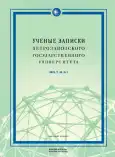THE IMAGE OF SEMIRAMIS IN THE PROSE OF FRANCESCO PETRARCH
- Авторлар: Razumovskaya E.A.1
-
Мекемелер:
- Saratov State University
- Шығарылым: Том 46, № 1 (2024)
- Беттер: 89-94
- Бөлім: Articles
- URL: https://journal-vniispk.ru/2542-1077/article/view/293260
- DOI: https://doi.org/10.15393/uchz.art.2024.996
- ID: 293260
Дәйексөз келтіру
Толық мәтін
Аннотация
The purpose of this article is to analyze the image of Queen Semiramis, its creation and functioning inthe prose work of F. Petrarch (1304–1374), “the first humanist of Europe”, based on the historical work “De virisillustribus” and letters from the collections “Epistolae sine titulo” and “De rebus familiaribus”. The image of Semiramishas been very significant in world literature and culture since antiquity, which determines the relevance of the research.The use of this image in the works of F. Petrarch has not yet been analyzed in domestic and foreign literature, whichdetermines the novelty of the chosen topic. The chapter on Semiramis was included in the second part o “De virisillustribus”, among the stories about the deeds of biblical heroes and legendary characters. In the biography of thequeen, Petrarch emphasizes her most important qualities, creating the image of a cruel warrior, builder and harlot. In hisextensive correspondence, Petrarch most often uses the image of Semiramis as one of the symbols of Babylon-Avignon,and Semiramis becomes the embodiment of the vices of the papal curia. Petrarch uses the positive connotation of theimage of Semiramis the warrior only in a letter to Empress Anna on the occasion of the birth of her daughter toemphasize the versatility of the female sex and its importance in the history of mankind. The image of Semiramis allowsPetrarch to create vivid, emotionally colored artistic and journalistic images of modernity. In addition, symbolic images like “Semiramis” are significant units of the international language of the new, humanistic culture, which Petrarch develops in his work to communicate with like-minded people.
Авторлар туралы
E. Razumovskaya
Saratov State University
Хат алмасуға жауапты Автор.
Email: razumovskaja@mail.ru
Cand. Sc. (Philologу)
Әдебиет тізімі
- Bibikhin, V. V. The word of Petrarch. In: Petrarch, F. Aesthetic fragments. Moscow, 1982. P. 7–37. (In Russ.)
- Devyataikina, N. I. Epistolae sine titulo by Petrarch in the historical and cultural contexts of the epoch. In: Petrarch, F. Epistolae sine nomine. Saratov, 2022. P. 100–223. (In Russ.)
- Devyataikina, N. I. Petrarch’s ideas about war, peace, military craft: ethical and symbolic components (on the dialogue “On military dignity”). Metamorphoses of History. 2021; 21: 7–17. (In Russ.)
- Devyataikina, N. I. Petrarch’s worldview: ethical views. Saratov, 1988. 208 p. (In Russ.)
- Zelyin, K. K. Pompeius Trogus and his work Historiae Philippicae. In: Justin, M. I. Epitome of Pompeius Trogus’s Historiae Philippicae. St. Petersburg, 2005. P. 5–33. (In Russ.)
- Lukyanova, L. M. [Preface to the translation]. Hermes Novus. 2022; 14(2): 70–71. (In Russ.)
- Matusevich, E. V. Italy and France: cultural opposition in the XIV–XV centuries. Voprosy filosofii. 2005; 9: 107–121. (In Russ.)
- Mingaleeva, N. H. Heaven and hell in Francesco Petrarch’s epic poem “Africa”. In: Myth in the Renaissance culture. Moscow, 2003. P. 5–33. (In Russ.)
- Khlodovsky, R. I. Francesco Petrarch. Poetry of humanism. Moscow, 1974. 176 p. (In Russ.)
- Kohl, B. G. Petrarch’s prefaces to De viris illustribus. History and Theory. 1974; 13: 132–144. doi: 10.2307/2504856
- Martinez, R. L. The book without a name: Petrarch’s open secret (Liber sine nomine). In: Petrarch. A critical guide to the complete works. (V. Kirkham, A. Maggi, Eds.). Chicago; London, 2009. P. 291–300.
- Mazzotta, G. The worlds of Petrarch. Durham; London, 1993. 232 p.
- Rossi, L. C. La “Vita di Ercole” del Petrarca. In: Le strade di Ercole. Itinerari umanistici e altri persorsi. Sismel, 2010. P. 169–187.
- Wilkins, E. H. Life of Petrarch. Chicago; London, 1961. 276 p.
Қосымша файлдар








